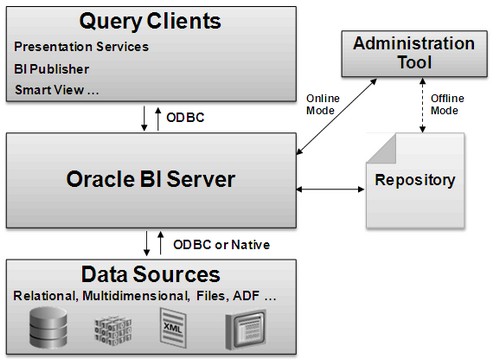OBIEE - BI Server (OBIS|nqsserver|nqs)
Introduction
OBI Server is also known as:
- OBIS (Oracle Business Intelligence Server)
- or nqsserver (The process name)
OBI Server is principally a query and analysis server software:
- that can integrate data via sophisticated capabilities from multiple sources. It acts then as a layer of abstraction and unification over the underlying databases.
- and serve them transparently to the Oracle BI Server clients through a conceptual/logical schema (the presentation layer) which act as a database (select clause only).
The Weblogic biserver is a Weblogic managed server and not an OBIEE BI Server.
>
The BI Server doesn't itself hold data, instead, it translates the incoming logical query into one or more outgoing “physical queries” against the relevant data sources.
The Oracle BI Server exposes its data dictionary (the presentation layer) through a standard ODBC 2.0 and a JDBC compliant interface. Clients of the Oracle BI Server see then a logical schema view (the presentation layer) independent of the source physical database schemas.
Oracle BI Server clients (such as Presentation Service) submit simplified logical SQL, which ultimately gets translated by the server to some combination of physical SQL sent to the back-end databases (or files), in addition to intermediate processing within the Oracle BI Server Execution Engine.
At a simplified level, the internal layers provides a OBIEE - Common Enterprise Information Model (CEIM) - The Logical Business Model (the three-layer metadata model) and have two primary functions:
Repository design is the creation and configuration task of this three layer and is the most important development part of BI Server.
The Oracle BI Server infrastructure includes facilities such as:
- statistics logging (log),
- monitoring (usage tracking, …),
Articles Related
Architecture features
Query Processing
To process the logical sql query in the most efficient way possible, the server includes:
- database-optimized SQL generation through the query compiler,
- query parsing,
- logical request generation,
- query rewrite with content aware data federation
- code generation,
Performance and scalability
The Oracle BI Server Design offers several performance and scalability optimizations including:
- sophisticated optimization algorithms
- custom heap memory management to avoid memory contention issues
- hashing to avoid central locking
- specialized synchronization mechanisms such as spin latches
- high-throughput connectivity adapters.
- latch contention
to optimize query processing and analysis.
When performance requirements exceed the capability of a single server, Oracle BI Servers can be clustered together with session replication and automatic fail-over.
Multithreaded Architecture
In Windows, the BI Server runs as a multithreaded service, and in UNIX, as a multithreaded process. The server loads all the metadata stored and processes queries based on what is configured in the repositories (The BI Server can access multiple repositories)
Accessing Oracle BI Server
Oracle BI Server presents itself through the presentation layer to other applications as an ODBC 2.0 and JDBC data source. This means that virtually any ODBC-JDBC-capable report writer or query tool can use the Oracle BI Server as if it were a relational database.
When it does, the query/reporting tool:
- does not need connectivity to underlying data sources;
- is completely insulated from changes in source tables and database platforms;
- immediately becomes aggregate aware;
- automatically takes advantage of the built-in security and connection pooling,
- and can use all the measures and columns of the subject area as if they were stored in a single simple database schema.
Users of these tools are insulated against returning erroneous results as a result of incorrect table joins or missing data – SQL traps sometimes known as:
- chasm traps,
- fan traps,
- or missing data traps.

